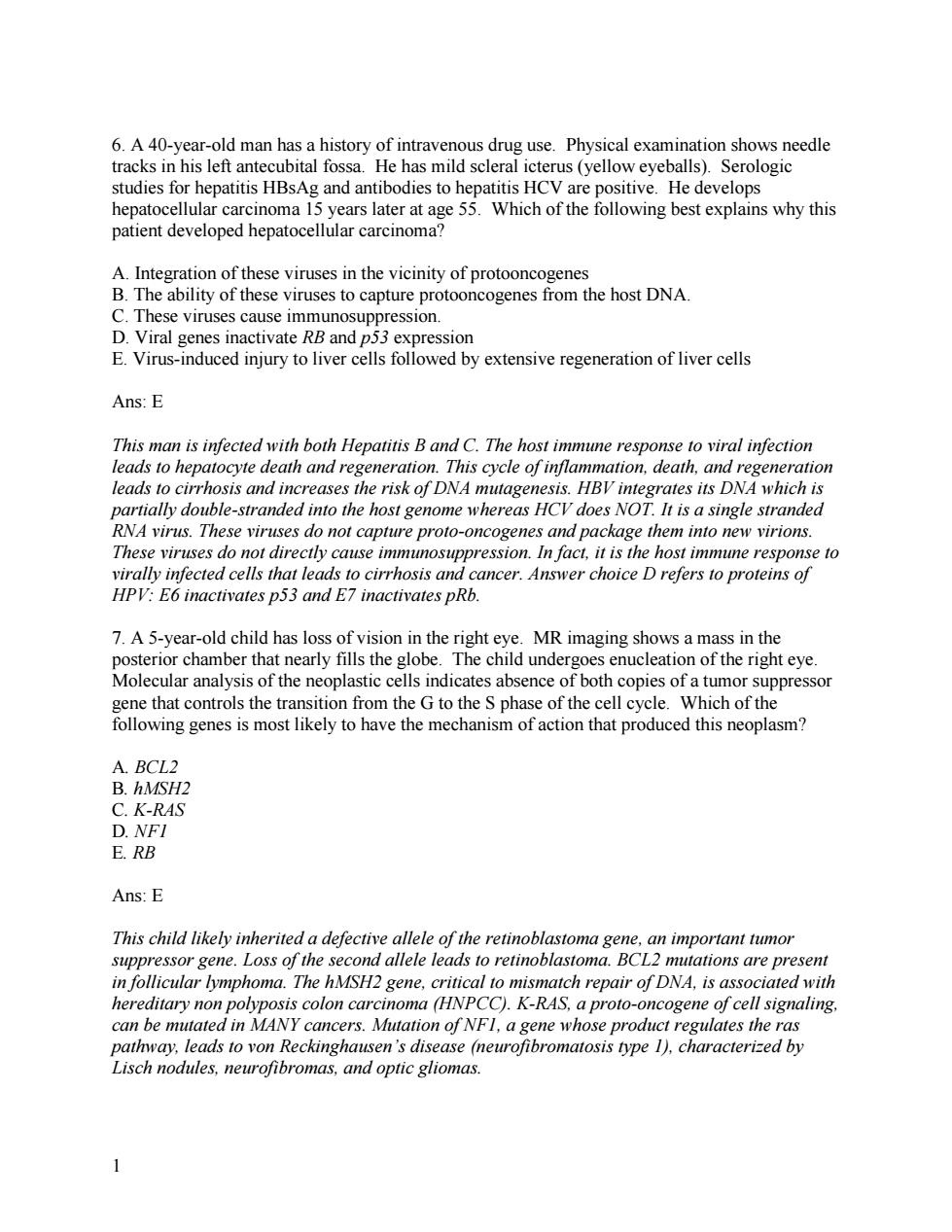正在加载图片...

6.A 40-year-old man has a history of intravenous drug use.Physical examination shows needle tracks in his left antecubital fossa.He has mild scleral icterus(yellow eyeballs).Serologic studies for hepatitis HBsAg and antibodies to hepatitis HCV are positive.He develops hepatocellular carcinoma 15 years later at age 55.Which of the following best explains why this patient developed hepatocellular carcinoma? A.Integration of these viruses in the vicinity of protooncogenes B.The ability of these viruses to capture protooncogenes from the host DNA. C These vin D Vira vate RR nd ed injury to liver cells foli d by extensive regeneration of liver cells Ans:E This man is infected with both Hepatitis B and C.The host immune response to viral infection leads to hepatocyte death and regeneration.This cycle of inflammation.death,and regeneration leads to cirrhosis and increases the risk of DNA mutagenesis.HBV integrates its DNA which is partially double-stranded into the host genome whereas HCV does NOT.It is a single stranded RNA virus.These viruses do not capture proto-oncogenes and package them into new virions. These viruses do not directly cause immunosuppression.In fact,it is the host immune response to virally infected cells that leads to cirrhosis and cancer.Answer choice D refers to proteins of HPV:E6 inactivates p53 and E7 inactivates pRb. 7.A 5-year-old child has loss of vision in the right eye.MR imaging shows a mass in the posterior chamber that nearly fills the globe.The child undergoes enucleation of the right eye. Mofthe e ces indicates absen of both cooftumor suppreso he that controls the transition from the G to the S phase of the cell c cle.Which of the nost likely to he me of action that pro duced this sm? C K-RAS Ans:E This child likely inherited a defective allele of the retinoblastoma gene,an important tumor suppressor gene.Loss of the second allele leads to retinoblastoma.BCL2 mutations are present in follicular lymphoma.The hMSH2 gene,critical to mismatch repair of DNA,is associated with hereditary non polyposis colon carcinoma (HNPCC).K-RAS,a proto-oncogene of cell signaling. can be mutated in MANY cancers.Mutation of NFI,a gene whose product regulates the ras pathway,leads to von Reckinghausen's disease (neurofibromatosis type 1),characterized by Lisch nodules,neurofibromas,and optic gliomas.1 6. A 40-year-old man has a history of intravenous drug use. Physical examination shows needle tracks in his left antecubital fossa. He has mild scleral icterus (yellow eyeballs). Serologic studies for hepatitis HBsAg and antibodies to hepatitis HCV are positive. He develops hepatocellular carcinoma 15 years later at age 55. Which of the following best explains why this patient developed hepatocellular carcinoma? A. Integration of these viruses in the vicinity of protooncogenes B. The ability of these viruses to capture protooncogenes from the host DNA. C. These viruses cause immunosuppression. D. Viral genes inactivate RB and p53 expression E. Virus-induced injury to liver cells followed by extensive regeneration of liver cells Ans: E This man is infected with both Hepatitis B and C. The host immune response to viral infection leads to hepatocyte death and regeneration. This cycle of inflammation, death, and regeneration leads to cirrhosis and increases the risk of DNA mutagenesis. HBV integrates its DNA which is partially double-stranded into the host genome whereas HCV does NOT. It is a single stranded RNA virus. These viruses do not capture proto-oncogenes and package them into new virions. These viruses do not directly cause immunosuppression. In fact, it is the host immune response to virally infected cells that leads to cirrhosis and cancer. Answer choice D refers to proteins of HPV: E6 inactivates p53 and E7 inactivates pRb. 7. A 5-year-old child has loss of vision in the right eye. MR imaging shows a mass in the posterior chamber that nearly fills the globe. The child undergoes enucleation of the right eye. Molecular analysis of the neoplastic cells indicates absence of both copies of a tumor suppressor gene that controls the transition from the G to the S phase of the cell cycle. Which of the following genes is most likely to have the mechanism of action that produced this neoplasm? A. BCL2 B. hMSH2 C. K-RAS D. NF1 E. RB Ans: E This child likely inherited a defective allele of the retinoblastoma gene, an important tumor suppressor gene. Loss of the second allele leads to retinoblastoma. BCL2 mutations are present in follicular lymphoma. The hMSH2 gene, critical to mismatch repair of DNA, is associated with hereditary non polyposis colon carcinoma (HNPCC). K-RAS, a proto-oncogene of cell signaling, can be mutated in MANY cancers. Mutation of NF1, a gene whose product regulates the ras pathway, leads to von Reckinghausen’s disease (neurofibromatosis type 1), characterized by Lisch nodules, neurofibromas, and optic gliomas